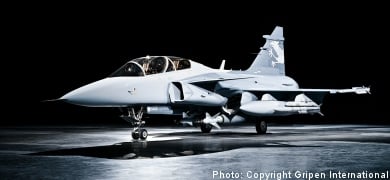On Monday, Saab and Sweden’s Minister of Defence announced that the Swedish aeronautics group would be bidding for a contract with the Norwegian Air Force for the purchase of up to 48 retooled Gripen aircraft.
The deal, which calls for Sweden to invest in upgrading the current generation of Gripen into a Nato-compatible Super-Gripen, was met with suspicion as well as downright hostility by many of Sweden’s major newspapers.
The Aftonbladet newspaper tears into the deal, calling it “a new black hole in the Swedish defence budget.” The paper argues that the additional costs to be borne by Swedish tax payers to help support the overhaul of the current generation of Gripen aircraft are more for the benefit of Sweden’s defence industry than to fill a gap in Sweden’s defences.
“Sweden doesn’t need a new combat airplane. The Air Force already has more plans than needed for any potential defence missions, and more than the budget allows us to use. The Gripen remains one of Swedish defence policy’s blackest of holes,” writes Aftonbladet.
All the more problematic is the fact that the deal comes at a time when Sweden’s defence budget is facing massive cuts, leaving the paper wondering how Defence Minister Sten Tolgfors will, “explain to the Swedish public and Armed Forces employees how it’s possible that we can afford a new airplane, but can’t afford to train soldiers or maintain air defences” in the northern two thirds of the country.
The Expressen newspaper is no less forgiving in its criticism of the deal, reminding readers of last year’s strife within the Moderate Party over defence spending which resulted in former defence minister Mikael Odenberg quitting in protest.
“Nine months later, one has to wonder if anything has really changed,” writes Expressen.
“The same old tune about the black hole in the defence budget continues to play as usual. And so does the politicians’ carefree feeding of the defence industry.”
The paper sees the Norway-Gripen deal to one of several which primarily benefit the “military-industrial complex”, leading the paper to wonder if Tolgfors ever relinquished the mentality he held in his former post as Sweden’s trade minister.
Nor does Expressen believe those who see the deal as the start of the Gripen’s ultimate salvation.
“Those who claim that the JAS Gripen stands on the verge of a large international breakthrough after years of crashes, empty order books, and bribery scandals have the evidence stacked against them,” writes the paper.
Göteborgs Posten (GP) is somewhat less negative towards the potential Gripen sale to Norway, but isn’t afraid to point out the many potential pitfalls in what it sees as a last ditch effort to breathe life into the program.
The paper attributes Sweden’s continued presence in the bidding to political changes in Norway that have strengthened voices calling for the country to reduce its dependence on the US, and to seek greater cooperation with Sweden.
“A Swedish-Norwegian deal could be the corner stone of such cooperation,” writes GP.
“Despite everything, however, it’s still a long way until the deal is closed and [Norway] decides against the [US-built] Joint Strike Fighter.”
GP also points out that Tolgors’s promise of having financing to overhaul the first ten Gripen aircraft has yet to be approved by the Riksdag, and that Supreme Commander Håkan Syrén hasn’t offered his support for the deal.
The paper concludes that an eventual purchase of the Gripen by Norway is the program’s last chance.
“Like an old, warn-out athlete, it’s all about winning, or leaving the playing field altogether.”
Writing in Dagens Nyheter, political analyst Henrik Brors attributes much of the problem to a disconnect between today’s security environment and the outmoded views that most Swedes have regarding Sweden’s role as a neutral nation.
“The new security policy ideology is that a few hundred thousand week Swedish guys with rifles and a few Jas airplanes aren’t enough to protect the country from a possible future attack. It’s much more frightening for any potential enemy to know that, when push comes to shove, several militarily powerful countries will come and stand by Sweden’s side,” writes Brors.
He faults policy makers for not doing a better job of presenting the argument to the Swedish public, which is has led to paradoxical poll numbers which show the public against joining Nato, but in support of cooperation with Nato-member and Nordic neighbor Norway.
PJ Anders Linder first sings the Gripen’s praises on the pages of the Svenska Dagbladet newspaper, pointing out how the planned upgrade associated with the Norway deal makes an excellent aircraft even better, which will ultimately benefit Sweden’s Air Force and the prospect of improved Nordic defence cooperation.
But then Linder poses the all important question: “How does the Super-JAS Gripen square with the rest of Swedish defence and security policy?”
He points out that Sweden’s military is already a shell of what it once was thanks to ever-shrinking budgets and continual cuts. Linder can’t help but poke fun at what the military itself sees as its mission.
“’The Armed Forces can defend Sweden in the event of an attack from a foreign power’ starts the military’s website in describing ‘our mission’, but which foreign Baltic Sea power do we currently need to defend ourselves against? The Hanseatic League?” he asks.
According to Linder, Sweden’s overseas peacekeeping operations “make a difference” in Afghanistan, Chad, and Kosovo, but that even these missions have been plagued by problems, many of which are attributable to cost saving measures.
More significant, however, is that none of the missions have a need for the Gripen or the Super Gripen.
In the end, Linder questions whether policy makers have their priorities right.
“Yes, the Super-JAS Gripen is a logical step, but only if those with political responsibility come to their senses. They must realize that combat aircraft are not enough and a thinned out home guard to protect our national integrity. Yes, that this sort of void contributes to increasing our insecurity,” he writes.
“It’s about the state’s most basic task. Mikael Odenberg quite because the government prioritized budget issues first and performed its security analysis after the fact. The situation is no better today.”
Where the main newspapers stand:
Dagens Nyheter, “independently liberal”, Stockholm-based, owned by the Bonnier family.
Svenska Dagbladet, “independently liberal-conservative”,
Stockholm-based, owned by Norwegian media company Schibsted.
Göteborgs-Posten, “independently liberal”,
Gothenburg-based, owned by the Stampen media group.
Sydsvenska Dagbladet (Sydsvenskan), “independently liberal”, Malmö-based, owned by the Bonnier family.
Aftonbladet, “independently Social Democrat”, Stockholm-based, owned by trade union federation LO and Norwegian media company Schibsted.
Expressen, “independently liberal”, Stockholm-based, owned by the Bonnier family.



 Please whitelist us to continue reading.
Please whitelist us to continue reading.